by Gary Alexander
November 5, 2024
Last week, we learned about GDP growth and job growth, but the headlines were more like head fakes.
First, the GDP headline mentioned 2.8% annualized GDP growth for the third quarter of 2024, which was a gift to the Biden/Harris team, but the details weren’t that kind to the incumbents. Government purchases (excluding transfer payments) grew at 5%, double the pace of the private sector’s 2.5%. Government spending growth has now surpassed consumer spending growth in eight of the last nine quarters.
In addition, the federal debt continues to increase about twice as fast as GDP, pushing our cumulative federal debt over $35 trillion, with neither candidate ever addressing their desired major cuts in spending.
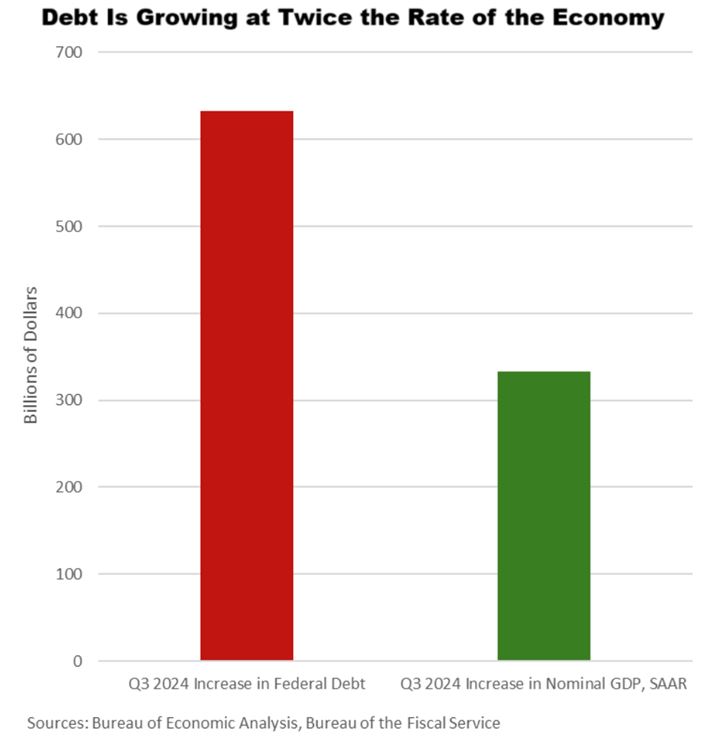
Graphs are for illustrative and discussion purposes only. Please read important disclosures at the end of this commentary.
As if this weren’t bad enough, the Treasury Department announced last week that the federal government plans to borrow another $1.369 trillion over the next six months – a $2.74 trillion annual rate, bringing the national debt to $38 trillion this time next year. (Someday, they’ll auction a bond, and nobody will buy it).
Turning to Friday’s jobs report, we saw another head fake, with a net “gain” of 12,000 jobs, but on closer examination, we saw private jobs decline for the first time since the government-imposed lock-downs of 2020. Private jobs fell by 28,000, while government jobs grew by 40,000, reaching a new record high.
The more you dip into the details, the worse the story gets, first, because the previous two months were revised downward by 112,000 jobs, and almost all the lost jobs were in construction, manufacturing, and business services. Despite claims of manufacturing job gains, that sector has lost 184,000 jobs since January 2023. Government jobs and government-dominated healthcare jobs accounted for almost two-thirds of recent job growth, while professional and business services, plus manufacturing, all showed annual job losses. This isn’t a robust private-sector recovery. After healthcare and government, the next fastest-growing job category is low-paying leisure and hospitality. And the biggest shock is that the number of part-time jobs make up the entire job gain picture, and then some, since the start of 2023.
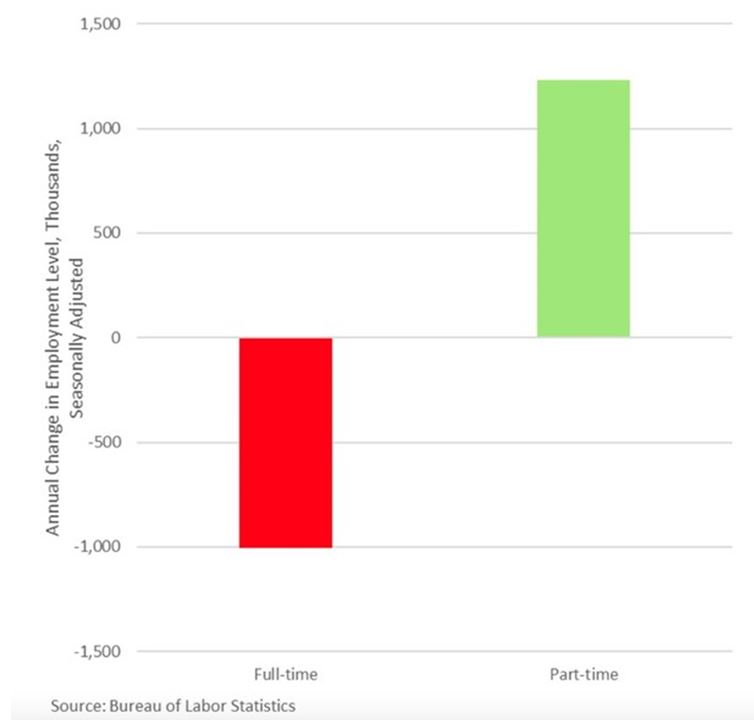
Graphs are for illustrative and discussion purposes only. Please read important disclosures at the end of this commentary.
Also, according to the BLS, native-born U.S. citizens have lost 773,000 jobs over the past 12 months, while foreign-born citizens or non-citizens gained 1,034,000 net new jobs. And if Trump wins, fulfilling his promise to deport some of those workers and close the borders, who will take up the job slack? A major new trend is that many young U.S. citizens prefer working part-time, off the books, or not at all.
The job opening picture is also turning dismal. The JOLTS report showed that job openings are now at their lowest level since early 2021 and below end-2018 levels. Openings have been trending down since early 2022, as have quits, which are now at the lowest level (excluding the Covid year) since early 2018.
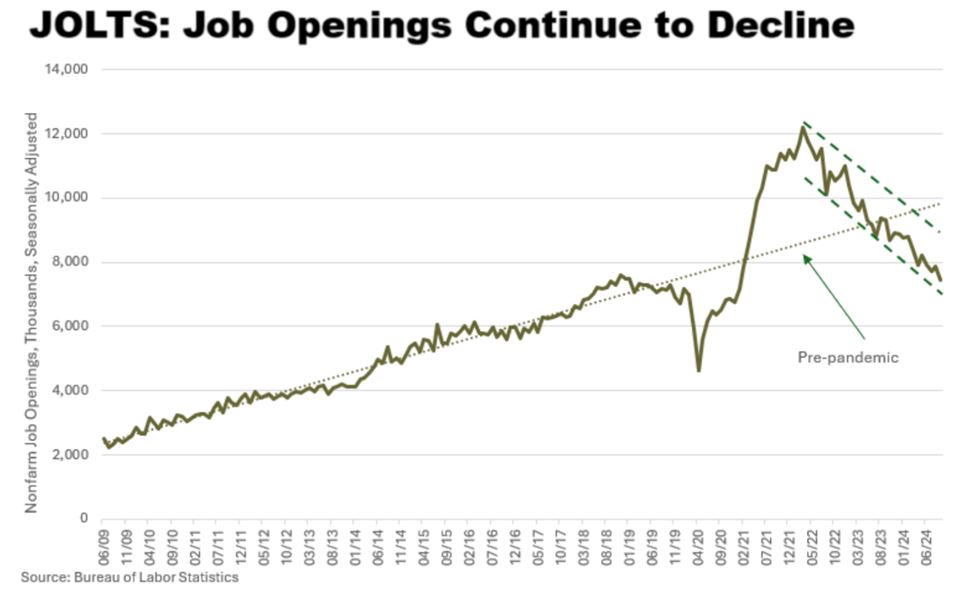
Graphs are for illustrative and discussion purposes only. Please read important disclosures at the end of this commentary.
Stock Market Gains – The Best Election Year Since 1936!
One growth number is for real: Through October 31, the S&P Growth Index is up a spunky 30.83% vs. less than half that, +14.36%, for S&P Value Index, according to Bespoke Investment Group. The same source told us that through October 31, this crazy 2024 campaign year is the best election year since 1936, with the S&P 500 up 19.6% and NASDAQ up 20.5%. However, Bespoke also tells us, there was no late-year follow-up to FDR’s big win, as the market dropped 0.3% in the final two months of 1936.
As I’ve documented here recently, the market has risen handsomely in the last three election years:

The late-year recoveries in 2016 and 2020 were quite dramatic, especially considering that the 2016 Trump victory was such an unexpected upset. As the Trump win began to sink in, New York Times Nobel-Prize winning economist Paul Krugman made a stunning prediction on the Times’ election night blog:
“It really does now look like President Donald J. Trump, and markets are plunging. When might we expect them to recover? Frankly, I find it hard to care much, even though this is my specialty. The disaster for America and the world has so many aspects that the economic ramifications are way down my list of things to fear. Still, I guess people want an answer: If the question is when markets will recover, a first-pass answer is never.” – Paul Krugman, writing at 12:42 am, Wednesday, November 9, 2016.
P.S. Over the next week, the Dow and S&P 500 each hit all-time highs and just kept rising.
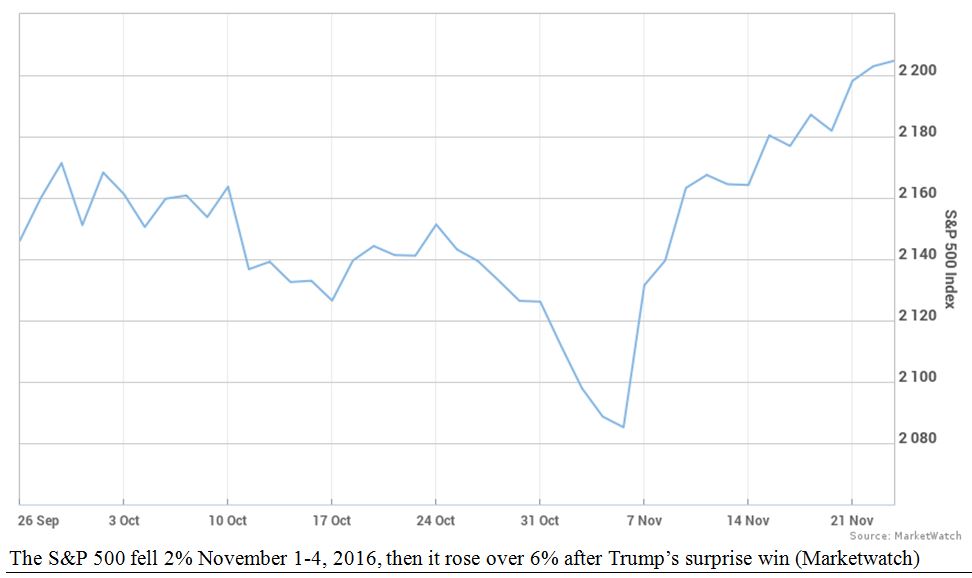
Graphs are for illustrative and discussion purposes only. Please read important disclosures at the end of this commentary.
Another Nobel Prize winning economist – one of the 2024 winners, just announced – also predicted a major market crash and recession if Donald Trump were elected in 2016. Writing on October 29, 2016, barely a week before the election, Simon Johnson, one of this year’s Nobel Prize winning economists, wrote an article entitled, “The Consequences of a Trump Shock.” Here is his opening paragraph in full:
“With the United States’ presidential election on November 8, and a series of elections and other political decisions fast approaching in Europe, now is a good time to ask whether the global economy is in good enough shape to withstand another major negative shock. The answer, unfortunately, is that growth and employment around the world look fragile. A big adverse surprise – like the election of Donald Trump in the US – would likely cause the stock market to crash and plunge the world into recession.”
–– 2024 Nobel-Prize winning economist Simon Johnson, October 29, 2016
Nope, no crash, no recession. So, how can two Nobel Prize winners (and others I could list) be so wrong? Probably because many of these group-think guys tend to bloviate in line with their political affiliations, ignoring the tools of their trade. In 2021, 17 Nobel Prize economics laureates strongly endorsed the Biden “Build Back Better” plan, and an even larger gaggle of Nobel laureates signed a letter saying the 2024 Kamala Harris economic agenda (unclear as it may be) is “vastly superior to the counter-productive agenda of President Trump,” since Nobel winners are a self-generating lot: Past winners nominate future candidates. (See “Nobelists for Harris Are Unburdened by Proof,” Wall Street Journal, October 30, 2024).
Three Possible Election Outcomes – From 200, 100 and 50 Years Ago This Week
Let me close with some notable election results from 200, 100 and 50 years ago this week – one disputed (even robbed, one could say) in 1824, a Republican sweep in 1924, and a Democratic sweep in 1974:
- On November 2, 1824, the Popular vote was recorded for the first time, but it was irrelevant, as Tennessee General Andrew Jackson beat John Quincy Adams in electoral votes, 99 to 84. Since Jackson failed to win 50%, there was some wheeling and dealing too complex to cover here, and in early 1825, the House declared Adams the winner. Jackson fumed, coming back to win in 1828. How interesting – the son of a President (John Adams), separated only by a middle initial (Q) beat a candidate from Tennessee by insider dealing – shades of George “W” Bush beating Al Gore in 2000?
- On November 4, 1924: Calvin Coolidge was re-elected with 54% of the vote, despite running against five other candidates: Democrat John W. Davis (with 29%), Progressive Robert LaFollette (16.5%), and three minor party candidates sharing 0.5%. Coolidge won 35 northern and western states, all but LaFollette’s home state, Wisconsin, while Davis swept the 12 southern states. On the same day, Nellie Tayloe Ross and Miriam Ferguson were elected the first female governors (in Wyoming and Texas).
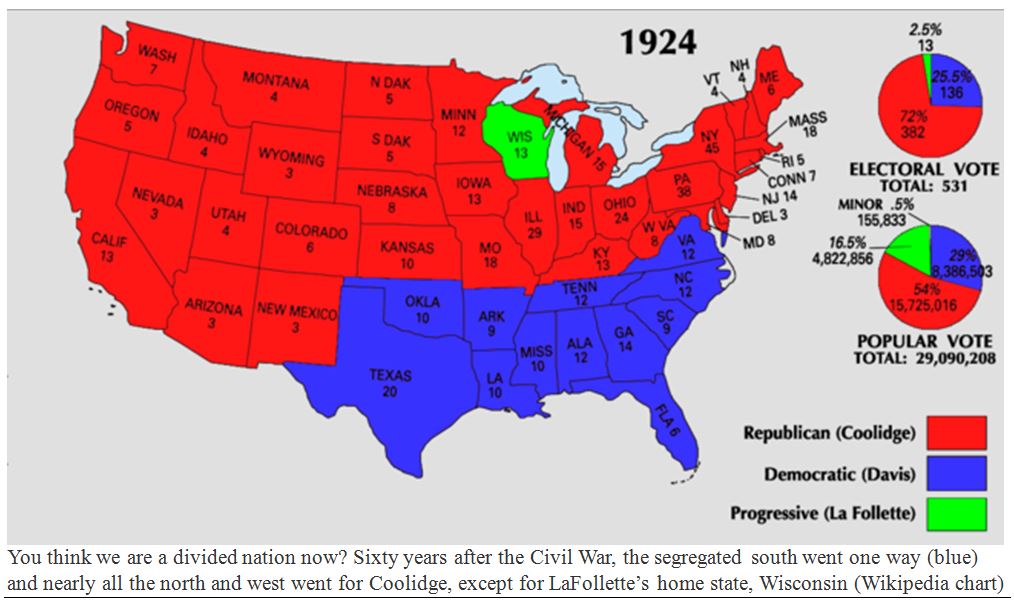
Graphs are for illustrative and discussion purposes only. Please read important disclosures at the end of this commentary.
- On November 5, 1974, in reaction to the Watergate scandal, Democrats gained a 2:1 majority in the House, gaining 43 seats to reach a 291-to-144 majority. The ratio was also high in the Senate, 61-37, with two independents. On the state level, Democrats won four more governor-ships, for a total of 36 (to 13 Republicans). The Dow reached its nadir of 577.6 within a month of this Democratic landslide.
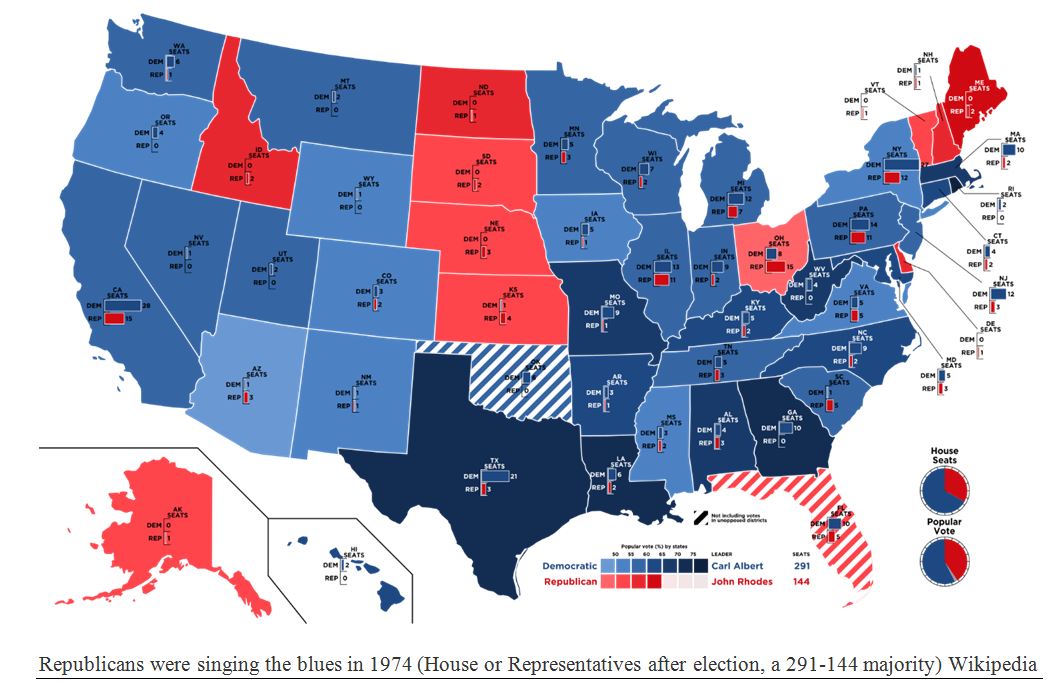
Graphs are for illustrative and discussion purposes only. Please read important disclosures at the end of this commentary.
What will happen this year? A long dispute, Red State Regrets or Blue State Blues? We’ll soon know…
All content above represents the opinion of Gary Alexander of Navellier & Associates, Inc.
Also In This Issue
A Look Ahead by Louis Navellier
Inflation is Down for Now, But What About 2025?
Income Mail by Bryan Perry
Investing In Election-Proof Themes For 2025
Growth Mail by Gary Alexander
What is Growth and What is a Mirage?
Global Mail by Ivan Martchev
The Big Election Week is Finally Here
Sector Spotlight by Jason Bodner
Don’t Expect Any Big Market Moves Right After the Election
View Full Archive
Read Past Issues Here
About The Author

Gary Alexander
SENIOR EDITOR
Gary Alexander has been Senior Writer at Navellier since 2009. He edits Navellier’s weekly Marketmail and writes a weekly Growth Mail column, in which he uses market history to support the case for growth stocks. For the previous 20-years before joining Navellier, he was Senior Executive Editor at InvestorPlace Media (formerly Phillips Publishing), where he worked with several leading investment analysts, including Louis Navellier (since 1997), helping launch Louis Navellier’s Blue Chip Growth and Global Growth newsletters.
Prior to that, Gary edited Wealth Magazine and Gold Newsletter and wrote various investment research reports for Jefferson Financial in New Orleans in the 1980s. He began his financial newsletter career with KCI Communications in 1980, where he served as consulting editor for Personal Finance newsletter while serving as general manager of KCI’s Alexandria House book division. Before that, he covered the economics beat for news magazines. All content of “Growth Mail” represents the opinion of Gary Alexander
Important Disclosures:
Although information in these reports has been obtained from and is based upon sources that Navellier believes to be reliable, Navellier does not guarantee its accuracy and it may be incomplete or condensed. All opinions and estimates constitute Navellier’s judgment as of the date the report was created and are subject to change without notice. These reports are for informational purposes only and are not a solicitation for the purchase or sale of a security. Any decision to purchase securities mentioned in these reports must take into account existing public information on such securities or any registered prospectus.To the extent permitted by law, neither Navellier & Associates, Inc., nor any of its affiliates, agents, or service providers assumes any liability or responsibility nor owes any duty of care for any consequences of any person acting or refraining to act in reliance on the information contained in this communication or for any decision based on it.
Past performance is no indication of future results. Investment in securities involves significant risk and has the potential for partial or complete loss of funds invested. It should not be assumed that any securities recommendations made by Navellier. in the future will be profitable or equal the performance of securities made in this report. Dividend payments are not guaranteed. The amount of a dividend payment, if any, can vary over time and issuers may reduce dividends paid on securities in the event of a recession or adverse event affecting a specific industry or issuer.
None of the stock information, data, and company information presented herein constitutes a recommendation by Navellier or a solicitation to buy or sell any securities. Any specific securities identified and described do not represent all of the securities purchased, sold, or recommended for advisory clients. The holdings identified do not represent all of the securities purchased, sold, or recommended for advisory clients and the reader should not assume that investments in the securities identified and discussed were or will be profitable.
Information presented is general information that does not take into account your individual circumstances, financial situation, or needs, nor does it present a personalized recommendation to you. Individual stocks presented may not be suitable for every investor. Investment in securities involves significant risk and has the potential for partial or complete loss of funds invested. Investment in fixed income securities has the potential for the investment return and principal value of an investment to fluctuate so that an investor’s holdings, when redeemed, may be worth less than their original cost.
One cannot invest directly in an index. Index is unmanaged and index performance does not reflect deduction of fees, expenses, or taxes. Presentation of Index data does not reflect a belief by Navellier that any stock index constitutes an investment alternative to any Navellier equity strategy or is necessarily comparable to such strategies. Among the most important differences between the Indices and Navellier strategies are that the Navellier equity strategies may (1) incur material management fees, (2) concentrate its investments in relatively few stocks, industries, or sectors, (3) have significantly greater trading activity and related costs, and (4) be significantly more or less volatile than the Indices.
ETF Risk: We may invest in exchange traded funds (“ETFs”) and some of our investment strategies are generally fully invested in ETFs. Like traditional mutual funds, ETFs charge asset-based fees, but they generally do not charge initial sales charges or redemption fees and investors typically pay only customary brokerage fees to buy and sell ETF shares. The fees and costs charged by ETFs held in client accounts will not be deducted from the compensation the client pays Navellier. ETF prices can fluctuate up or down, and a client account could lose money investing in an ETF if the prices of the securities owned by the ETF go down. ETFs are subject to additional risks:
- ETF shares may trade above or below their net asset value;
- An active trading market for an ETF’s shares may not develop or be maintained;
- The value of an ETF may be more volatile than the underlying portfolio of securities the ETF is designed to track;
- The cost of owning shares of the ETF may exceed those a client would incur by directly investing in the underlying securities; and
- Trading of an ETF’s shares may be halted if the listing exchange’s officials deem it appropriate, the shares are delisted from the exchange, or the activation of market-wide “circuit breakers” (which are tied to large decreases in stock prices) halts stock trading generally.
Grader Disclosures: Investment in equity strategies involves substantial risk and has the potential for partial or complete loss of funds invested. The sample portfolio and any accompanying charts are for informational purposes only and are not to be construed as a solicitation to buy or sell any financial instrument and should not be relied upon as the sole factor in an investment making decision. As a matter of normal and important disclosures to you, as a potential investor, please consider the following: The performance presented is not based on any actual securities trading, portfolio, or accounts, and the reported performance of the A, B, C, D, and F portfolios (collectively the “model portfolios”) should be considered mere “paper” or pro forma performance results based on Navellier’s research.
Investors evaluating any of Navellier & Associates, Inc.’s, (or its affiliates’) Investment Products must not use any information presented here, including the performance figures of the model portfolios, in their evaluation of any Navellier Investment Products. Navellier Investment Products include the firm’s mutual funds and managed accounts. The model portfolios, charts, and other information presented do not represent actual funded trades and are not actual funded portfolios. There are material differences between Navellier Investment Products’ portfolios and the model portfolios, research, and performance figures presented here. The model portfolios and the research results (1) may contain stocks or ETFs that are illiquid and difficult to trade; (2) may contain stock or ETF holdings materially different from actual funded Navellier Investment Product portfolios; (3) include the reinvestment of all dividends and other earnings, estimated trading costs, commissions, or management fees; and, (4) may not reflect prices obtained in an actual funded Navellier Investment Product portfolio. For these and other reasons, the reported performances of model portfolios do not reflect the performance results of Navellier’s actually funded and traded Investment Products. In most cases, Navellier’s Investment Products have materially lower performance results than the performances of the model portfolios presented.
This report contains statements that are, or may be considered to be, forward-looking statements. All statements that are not historical facts, including statements about our beliefs or expectations, are “forward-looking statements” within the meaning of The U.S. Private Securities Litigation Reform Act of 1995. These statements may be identified by such forward-looking terminology as “expect,” “estimate,” “plan,” “intend,” “believe,” “anticipate,” “may,” “will,” “should,” “could,” “continue,” “project,” or similar statements or variations of such terms. Our forward-looking statements are based on a series of expectations, assumptions, and projections, are not guarantees of future results or performance, and involve substantial risks and uncertainty as described in Form ADV Part 2A of our filing with the Securities and Exchange Commission (SEC), which is available at www.adviserinfo.sec.gov or by requesting a copy by emailing info@navellier.com. All of our forward-looking statements are as of the date of this report only. We can give no assurance that such expectations or forward-looking statements will prove to be correct. Actual results may differ materially. You are urged to carefully consider all such factors.
FEDERAL TAX ADVICE DISCLAIMER: As required by U.S. Treasury Regulations, you are informed that, to the extent this presentation includes any federal tax advice, the presentation is not written by Navellier to be used, and cannot be used, for the purpose of avoiding federal tax penalties. Navellier does not advise on any income tax requirements or issues. Use of any information presented by Navellier is for general information only and does not represent tax advice either express or implied. You are encouraged to seek professional tax advice for income tax questions and assistance.
IMPORTANT NEWSLETTER DISCLOSURE:The hypothetical performance results for investment newsletters that are authored or edited by Louis Navellier, including Louis Navellier’s Growth Investor, Louis Navellier’s Breakthrough Stocks, Louis Navellier’s Accelerated Profits, and Louis Navellier’s Platinum Club, are not based on any actual securities trading, portfolio, or accounts, and the newsletters’ reported hypothetical performances should be considered mere “paper” or proforma hypothetical performance results and are not actual performance of real world trades. Navellier & Associates, Inc. does not have any relation to or affiliation with the owner of these newsletters. There are material differences between Navellier Investment Products’ portfolios and the InvestorPlace Media, LLC newsletter portfolios authored by Louis Navellier. The InvestorPlace Media, LLC newsletters contain hypothetical performance that do not include transaction costs, advisory fees, or other fees a client might incur if actual investments and trades were being made by an investor. As a result, newsletter performance should not be used to evaluate Navellier Investment services which are separate and different from the newsletters. The owner of the newsletters is InvestorPlace Media, LLC and any questions concerning the newsletters, including any newsletter advertising or hypothetical Newsletter performance claims, (which are calculated solely by Investor Place Media and not Navellier) should be referred to InvestorPlace Media, LLC at (800) 718-8289.
Please note that Navellier & Associates and the Navellier Private Client Group are managed completely independent of the newsletters owned and published by InvestorPlace Media, LLC and written and edited by Louis Navellier, and investment performance of the newsletters should in no way be considered indicative of potential future investment performance for any Navellier & Associates separately managed account portfolio. Potential investors should consult with their financial advisor before investing in any Navellier Investment Product.
Navellier claims compliance with Global Investment Performance Standards (GIPS). To receive a complete list and descriptions of Navellier’s composites and/or a presentation that adheres to the GIPS standards, please contact Navellier or click here. It should not be assumed that any securities recommendations made by Navellier & Associates, Inc. in the future will be profitable or equal the performance of securities made in this report.
FactSet Disclosure: Navellier does not independently calculate the statistical information included in the attached report. The calculation and the information are provided by FactSet, a company not related to Navellier. Although information contained in the report has been obtained from FactSet and is based on sources Navellier believes to be reliable, Navellier does not guarantee its accuracy, and it may be incomplete or condensed. The report and the related FactSet sourced information are provided on an “as is” basis. The user assumes the entire risk of any use made of this information. Investors should consider the report as only a single factor in making their investment decision. The report is for informational purposes only and is not intended as an offer or solicitation for the purchase or sale of a security. FactSet sourced information is the exclusive property of FactSet. Without prior written permission of FactSet, this information may not be reproduced, disseminated or used to create any financial products. All indices are unmanaged and performance of the indices include reinvestment of dividends and interest income, unless otherwise noted, are not illustrative of any particular investment and an investment cannot be made in any index. Past performance is no guarantee of future results.
